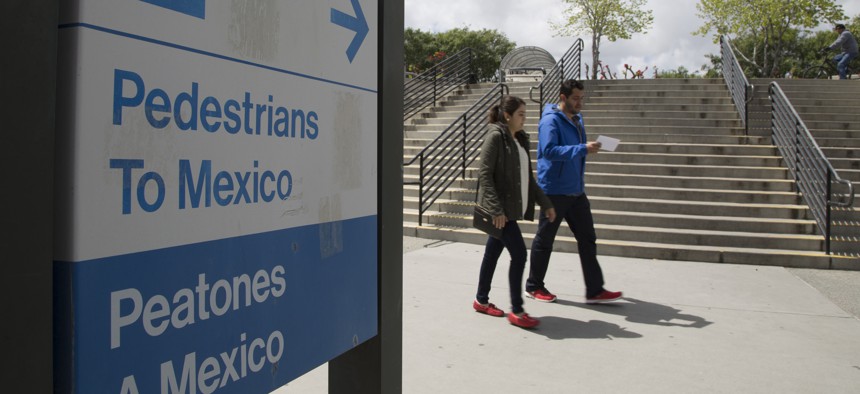
Customs and Border Protection
U.S. Immigration Policy Has Lost Touch With U.S. Immigration Reality
The system was designed to deal with Mexican migrant workers, not refugees from violence and war.
The US has long viewed immigrants who enter the country illegally as belonging to two groups. There are Mexicans, and there is everyone else.
The focus on Mexicans, who are the majority, and who traditionally migrate for economic reasons, has resulted in policies aimed at blocking off the border and quickly turning back those who breach it.
But these days, the share of “Other than Mexicans”, or OTMs—yes, this is an official classification—is much larger than in the past. And while some of them might have been lured by the promise of a job, like their Mexican counterparts, many of them are women and children fleeing violence and crime in Central America.
This mixed flow, experts say, poses a different challenge for the immigration system: how to quickly and fairly determine who has a legitimate need for protection. So far, though, many politicians seem to be stuck on the idea of keeping people out (including Republican presidential candidate Donald Trump, with his idea for a giant wall between the US and Mexico).
“The popular debate has not caught up to the reality of the border,” said Marc Rosenblum, who worked at the Migration Policy Institute when I interviewed him earlier this year, and now works for the US Department of Homeland Security (DHS).
“Other than Mexicans,” mostly Central Americans, accounted for 44% of immigrants caught by the border patrol in fiscal year 2015, according to DHS data (pdf, p. 1). In the first eight months of fiscal 2016, OTMs were fully half of those caught:
OTMs would have likely made up an even bigger share had Mexico itself not launched an aggressive border-enforcement campaign in 2014, with help from the US (pdf, page 15.) Mexican authorities have been deporting more Central American immigrants than the US, sending 150,000 of them home in 2015, according to Mexico’s interior ministry.
To be sure, apprehensions are only a proxy for illegal immigration. But the trend is clear. Fewer Mexicans are finding reasons to cross the border illegally, and more are coming to the US under temporary work visas. In fiscal 2015, the US caught fewer than 190,000 Mexicans, down from nearly 230,000 (pdf, page 2) the previous year and more than one million in fiscal 2005.
Meanwhile, an exodus of residents of Central America’s Northern Triangle—El Salvador, Guatemala, and Honduras—continues to flow towards the US. What’s pushing them to flee is up for debate. Some say it’s out-of-control violence and crime in those countries; others say it’s a severe drought that has ravaged farm lands and left many hungry. Anti-immigration advocates say they’re coming because US immigration policy is too lax.
But whatever the reason, one thing is clear: These aren’t obviously economic migrants like the millions of Mexicans who came before them. Many of them more closely resemble the Middle Eastern refugees now reaching Europe. Nearly half of the Central Americans captured in the US in fiscal 2015 were families or children traveling alone, DHS data show. Many are not trying to evade border patrol agents, but look for them, so they can turn themselves in (paywall.) Nearly 24,000 of them (pdf, page 12) requested asylum in the first six months of 2015.
A system struggling to cope
This shift in the type of illegal immigrant has put a strain on the US immigration system. Mexican economic migrants can simply be dropped off on the Mexican side of the border after being caught, but Central Americans claiming asylum must go through a slower and more complicated process. Meanwhile they have to be housed and fed, or released until a judge can determine whether they can stay or not. The court system is getting increasingly clogged.
A surge in children and families during the summer of 2014 showed how poorly prepared the US was to deal with this new kind of immigrant. Emergency measures, from setting up makeshift detention facilities to conducting immigration hearings via webcast, worked—but only temporarily. After dropping substantially in fiscal 2015, the numbers of family members traveling together and children caught at the border between October 2015 and May 2016 nearly doubled over the same period last year.
In response, the US government has opened up shelters for immigrant children and added more immigration judges. To deter immigrants in the first place, it’s begun screening (pdf) asylum seekers before they leave their countries. And it’s also dispatched officials to tell Central Americans that the US’s doors are not open to illegal immigration, and to warn them about the perils of the trip north.
But there’s a lot more it could be doing to ensure those who do need protection get it, according to Rosenblum. For example, rather than funneling thousands of asylum claims through the overworked courts, it should allow immigration officials to decide who has a valid claim at the border, he suggests.
Then, he argues, those whose cases do go to court should get a lawyer; many immigrants don’t. And even if Central Americans don’t strictly qualify for asylum, the US should acknowledge the dangers they face back home by letting them stay temporarily, like it does with victims of natural disasters or civil war.
This wouldn’t be the first time the US overhauled its asylum system. With a backlog of more than 400,000 asylum cases in 1994, the government streamlined the process and added personnel. Five years later, the number of claims was down 75% and a bigger proportion of the immigrants who applied for asylum got it. That experience holds some lessons (pdf, pg. 5) that could be useful today.






